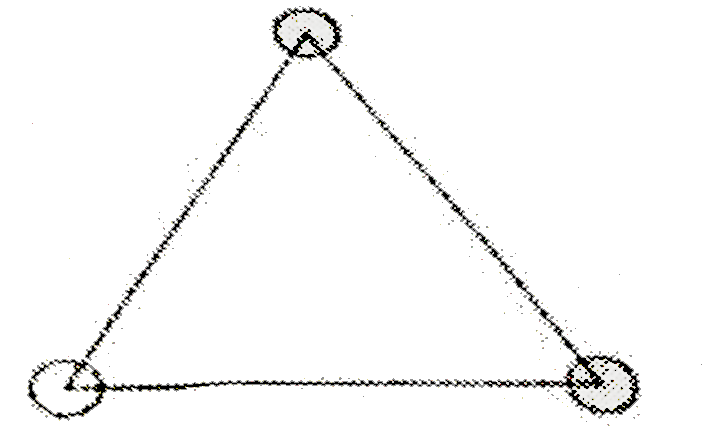Three identical spheres each of radius a and mass m are placed such that their centers lie on the vertices of an equilateral triangle of side length 3a. The spheres are non conducting and each one carries a charge Q uniformly distributed over its surface. All the three spheres are simultaneously released and after releasing they move under the influence of their mutual electrostatic forces only. Based on this information, answer the following questions :
The total electrostatic potential energy stored in the system at the time of releasing is :
KQ22a
3KQ22a
5KQ22a
15KQ22a
The correct Answer is:C
To find the total electrostatic potential energy stored in the system of three identical spheres, we will break down the problem step by step.
Step 1: Understand the Configuration
We have three identical spheres, each with a charge Q, radius a, and mass m. The centers of these spheres form the vertices of an equilateral triangle with a side length of 3a.
Step 2: Calculate the Self-Energy of Each Sphere
The self-energy Uself of a charged sphere can be calculated using the formula:
Uself=kQ22a
where k is Coulomb's constant.
Since there are three identical spheres, the total self-energy of the system is:
Uself, total=3×Uself=3×kQ22a=3kQ22a
Step 3: Calculate the Interaction Energy Between the Spheres
Next, we need to calculate the interaction energy between each pair of spheres. The distance between the centers of any two spheres is 3a.
The interaction energy Uinteraction between two charges Q separated by a distance r is given by:
Uinteraction=kQ2r
For our case, since the distance r=3a, the interaction energy between any two spheres is:
Uinteraction=kQ23a
Since there are three pairs of spheres (A-B, A-C, and B-C), the total interaction energy is:
Uinteraction, total=3×kQ23a=kQ2a
Step 4: Calculate the Total Electrostatic Potential Energy
The total electrostatic potential energy Utotal of the system is the sum of the total self-energy and the total interaction energy:
Utotal=Uself, total+Uinteraction, total
Substituting the values we calculated:
Utotal=3kQ22a+kQ2a
To combine these terms, we can express kQ2a as 2kQ22a:
Utotal=3kQ22a+2kQ22a=5kQ22a
Final Answer
Thus, the total electrostatic potential energy stored in the system at the time of releasing is:
5kQ22a
We have three identical spheres, each with a charge Q, radius a, and mass m. The centers of these spheres form the vertices of an equilateral triangle with a side length of 3a.
The self-energy Uself of a charged sphere can be calculated using the formula:
Uself=kQ22a
where k is Coulomb's constant.
Uself, total=3×Uself=3×kQ22a=3kQ22a
Next, we need to calculate the interaction energy between each pair of spheres. The distance between the centers of any two spheres is 3a.
Uinteraction=kQ2r
For our case, since the distance r=3a, the interaction energy between any two spheres is:
Uinteraction=kQ23a
Uinteraction, total=3×kQ23a=kQ2a
The total electrostatic potential energy Utotal of the system is the sum of the total self-energy and the total interaction energy:
Utotal=Uself, total+Uinteraction, total
Substituting the values we calculated:
Utotal=3kQ22a+kQ2a
Utotal=3kQ22a+2kQ22a=5kQ22a
Thus, the total electrostatic potential energy stored in the system at the time of releasing is:
5kQ22a
Similar Questions
Knowledge Check
- Question 1 - Select One
Three identical spheres each of radius a and mass m are placed such that their centers lie on the vertices of an equilateral triangle of side length 3a. The spheres are non conducting and each one carries a charge Q uniformly distributed over its surface. All the three spheres are simultaneously released and after releasing they move under the influence of their mutual electrostatic forces only. Based on this information, answer the following questions :
The rate at which the electrostatic potential energy of the system is decreasing, just after the release will be :AZeroBKQ22abCaKQ22abDDependent on the mass of each sphere - Question 2 - Select One
Three identical spheres each of radius a and mass m are placed such that their centers lie on the vertices of an equilateral triangle of side length 3a. The spheres are non conducting and each one carries a charge Q uniformly distributed over its surface. All the three spheres are simultaneously released and after releasing they move under the influence of their mutual electrostatic forces only. Based on this information, answer the following questions :
Suppose that some time after the release, the distance between the spheres becomes 5a and the speed of each sphere becomes v. Then, at this instant, the rate of change of potential energy of the system will be:AZeroB-(3sqrt3KQ^(2))/(25a^(2))vC-((KQ^(2))/(3a^(2)))vD-((KQ^(2))/(2a^(2)sqrt3))v - Question 3 - Select One
Three identical spheres of mass m each are placed at the corners of an equilateral triangle of side 2m taking one of the corner as the origin the position vector of the centre of mass is
A√3(I∩−j∩)BI∩√3+j∩CI∩+j∩3DI∩+j∩√3
Three small conducting spheres each of radius a and charge q is placed at the corners of an equilateral triangle of side lenth /. The side lenth / is considerably larger than dimensions of the spheres. Find the electrical potential energy of system.
 View Solution
View SolutionThree identical spheres each of radius 3cm are placed on a horizontal surface touching one another. The distance of centre of mass of system from any centre of the sphere is
View SolutionThree identical spheres of mass m each are placed at the corners of an equilateral triangle of side 2m taking one of the corner as the origin the position vector of the centre of mass is
View SolutionThree identical spheres of mass M each are placed at the corners of an equilateral triangle of side 2 m. Taking one of the corners as the origin, the position vector of the centre of mass is
View SolutionThree identical spheres each of mass m and radius R are placed touching each other so that their centres A,B and C lie on a straight line. The position of their centre of mass from centre of A is
View Solution

